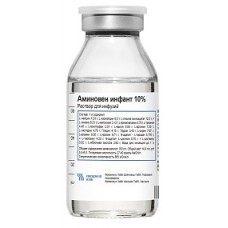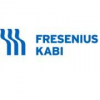Expiration date: 06/2026
The composition and form of issue:
Solution for infusion 6% 1 litre contains:
L-isoleucine 4.8 g
L-leucine 7.8 g
L-lysine monoacetate 7.2 g
(corresponds to 5.11 g of L-lysine)
L-methionine 1,872 g
L-phenylalanine 2.25 g
L-threonine is 2,64 g
L-tryptophan is 1,206 g
L-valine, 5.4 g
L-arginine 4.5 g
L-histidine 2,856 g
a solution of 2.49 g
L-alanine 5,58 g
L-Proline 5,826 g
L-serine 4,602 g
taurine 0.24 g
N-acetyl-L-cysteine 0.42 g
(corresponds to 0,312 g L-cysteine)
N-acetyl-L-tyrosine 3,106 g
(corresponds to 2,52 g of L-tyrosine)
L-malic acid 1,572 g
water for injections up to 1 l
total amino acid contents 60 g
the total nitrogen content of 9 g
titratable acidity — 27-40 mmol NaOH/l
pH of 5.5–6.0
theoretical osmolarity — 531 mOsm/l
in glass bottles of 100 or 250 ml cartons of 10 vials.
Solution for infusion 10% 1 litre contains:
L-isoleucine 8 g
L-leucine 13 g
L-lysine monoacetate 12 g
(meets of 8.51 g L-lysine)
L-methionine 3,12 g
L-phenylalanine 3.75 g
L-threonine 4.4 g
L-tryptophan is 2.01 g
L-valine 9 g
L-arginine 7.5 g
L-histidine was 4.76 g
glycine 4.15 grams
L-alanine 9.3 g
L-Proline of 9.71 g
L-serine of 7.67 g
taurine 0.4 g
N-acetyl-L-cysteine 0.7 g
(corresponds to 0.52 g of L-cysteine)
N-acetyl-L-tyrosine 5,176 g
(corresponds to 4.2 g of L-tyrosine)
L-malic acid, 2.62 g
water for injections up to 1 l
the total content of amino acids in 100 g
total nitrogen content of 14.9 g
titratable acidity — 27-40 mmol NaOH/l
pH of 5.5–6.0
theoretical osmolarity — 885 mOsm/l
in glass bottles of 100 or 250 ml cartons of 10 vials.
Description pharmaceutical form:
Clear, colorless solution.
Feature:
A means of parenteral nutrition.
Pharmacokinetics:
At/in a bioavailability of 100%. Amino acids are distributed into the interstitial fluid and the extracellular space of organs and tissues. Proper introduction (slow and constant speed) Aminoven infant does not violate the balance of amino acids. A small part of amino acids is eliminated by the kidneys.
Description pharmacological action:
After parenteral administration of amino acids included in the pool of free amino acids in the body and are involved in all metabolic processes, in particular, are used for protein synthesis. Taurine is not included in the composition of proteins, but is required for the normal development of the brain and retina of the eye for normal metabolism of bile acids.
Clinical pharmacology:
In severe impaired renal function and liver, the balance of amino acids is disturbed. In this case, you should use a special amino acid solutions for parenteral nutrition.
Indications:
Partial parenteral nutrition of newborns, infants and prematurity.
Total parenteral nutrition in combination with solutions of carbohydrates, fat emulsion, vitamins, electrolytes and trace elements.
Contraindications:
Violation of amino acid metabolism, metabolic acidosis, gipergidratace, hypokalemia. In hepatic and renal failure — requires individual dosing.
Side effects:
With the rapid introduction of the drug into a peripheral vein may be signs of a local reaction: redness, phlebitis, thrombosis.
Drug interactions:
Should not be mixed with drugs that are not intended for parenteral nutrition.
Method of application and dose:
In/in, drip (long-term), in the peripheral or Central vein (Aminoven infant 6%) and mainly in the Central vein (Aminoven infant 10%).
Aminoven infant 6%
The maximum speed of input — up to 0.1 g/kg/h amino acids, which is equal to 1.67 ml/kg/h.
The maximum daily dose for children under 1 year — 1,5–2,5 g/kg amino acids, or 25 to 40 ml/kg 2-5 years 1.5 g/kg amino acids, or 25 ml/kg.
Aminoven infant 10%
The maximum speed of input — up to 0.1 g/kg/h amino acids, which is equal to 1 ml/kg/h.
The maximum daily dose for children under 1 year — 1,5–2,5 g/kg amino acids, or 15-25 ml/kg 2-5 years 1.5 g/kg amino acids, or 15 ml/kg 6-14 years — 1 g/kg amino acids or 10 ml/kg.
The drug is used as long as there remains a need for parenteral nutrition.
Overdose:
Symptoms: chills, nausea, vomiting, kidney aminoacidos. Possible acute circulatory failure.
Precautions:
Recommended daily control of the area of the puncture.
For parenteral nutrition of young children should consider the following indicators: the concentration of nitrogen in the urine, ammonia, glucose, electrolytes, triglycerides (additional administration of fat emulsions), the activity of liver enzymes, serum osmolality, acid-base balance and water-salt metabolism.
Too rapid infusion may lead to loss of amino acids through the kidneys, resulting in an imbalance of amino acids.
Solutions of amino acids due to the increased risk of microbial contamination should not be mixed with other drugs.
Special instructions:
Open a bottle with the drug should be stored in a refrigerator at a temperature not above 10 °C not more than 24 hours.


